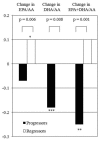A predictor of atheroma progression in patients achieving very low levels of low-density lipoprotein cholesterol
- PMID: 24224137
- PMCID: PMC3819585
A predictor of atheroma progression in patients achieving very low levels of low-density lipoprotein cholesterol
Abstract
An aggressive reduction in low-density lipoprotein cholesterol (LDL-C) with statins produces regression or stabilization of coronary artery plaques. However, after achieving very low levels of LDL-C, atheroma regression is not observed in all patients. The purpose of the present study was to evaluate the determinants of atheroma progression despite achieving very low levels of LDL-C. The effects of 8-month statin therapy on coronary atherosclerosis were evaluated using virtual histology intravascular ultrasound in the TRUTH study. Of these, 33 patients who achieved an on-treatment LDL-C level of <70 mg/dl were divided into 2 groups according to increase in plaque volume (progressors, n= 16) or decrease in plaque volume (regressors, n= 17) during an 8-month follow-up period. At the 8-month follow-up, serum LDL-C and apolipoprotein B levels were significantly lower in progressors than in regressors; however, significant increases in high-density lipoprotein cholesterol and apolipoprotein AI and decreases in high-sensitivity C-reactive protein and oxidized LDL were observed only in regressors. The changes in the n-3 to n-6 polyunsaturated fatty acid ratios significantly differed between the 2 groups. Multivariate regression analysis showed that a decrease in the eicosapentaenoic acid + docosahexaenoic acid/arachidonic acid ratio was a significant predictor associated with atheroma progression (β= -0.512, p= 0.004). In conclusions, n-3 to n-6 polyunsaturated fatty acid ratios affected coronary artery plaque progression and regression in patients who achieved very low levels of LDL-C during statin therapy.
Keywords: Atheroma; low-density lipoprotein cholesterol; polyunsaturated fatty acid; statin; virtual histology intravascular ultrasound.
Figures


References
-
- Hiro T, Kimura T, Morimoto T, Miyauchi K, Nakagawa Y, Yamagishi M, Ozaki Y, Kimura K, Saito S, Yamaguchi T, Daida H, Matsuzaki M JAPAN-ACS Investigators. Effect of intensive statin therapy on regression of coronary atherosclerosis in patients with acute coronary syndrome: a multicenter randomized trial evaluated by volumetric intravascular ultrasound using pitava-statin versus atorvastatin (JAPAN-ACS [Japan assessment of pitavastatin and atorvastatin in acute coronary syndrome] study) J Am Coll Cardiol. 2009;54:293–302. - PubMed
-
- Okazaki S, Yokoyama T, Miyauchi K, Shimada K, Kurata T, Sato H, Daida H. Early statin treatment in patients with acute coronary syndrome: demonstration of the beneficial effect on atherosclerotic lesions by serial volumetric intravascular ultrasound analysis during half a year after coronary event: the ESTABLISH Study. Circulation. 2004;110:1061–1068. - PubMed
-
- Nissen SE, Nicholls SJ, Sipahi I, Libby P, Raichlen JS, Ballantyne CM, Davignon J, Erbel R, Fruchart JC, Tardif JC, Schoenhagen P, Tim Crowe T, Cain V, Wolski K, Goormastic M, Tuzcu EM ASTEROID Investigators. Effect of very high-intensity statin therapy on regression of coronary atherosclerosis: the ASTEROID trial. JAMA. 2006;295:1556–1565. - PubMed
-
- Aikawa M, Rabkin E, Sugiyama S, Voglic SJ, Fukumoto Y, Furukawa Y, Shiomi M, Schoen FJ, Libby P. An HMG-CoA reductase inhibitor, cerivastatin, suppresses growth of macrophages expressing matrix metalloproteinases and tissue factor in vivo and in vitro. Circulation. 2001;103:276–283. - PubMed
-
- LaRosa JC, Grundy SM, Waters DD, Shear C, Barter P, Fruchart JC, Gotto AM, Greten H, Kastelein JJ, Shepherd J, Wenger NK. Treating to New Targets (TNT) Investigators. Intensive lipid lowering with atorvastatin in patients with stable coronary disease. N Engl J Med. 2005;352:1425–1435. - PubMed
LinkOut - more resources
Full Text Sources
Research Materials
